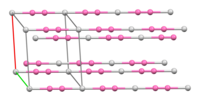
Photo from wikipedia
Abstract The nature of the electrostatic responses of the vibrational and NMR spectroscopic properties is analyzed theoretically for the cyanide anion and the cyanide ligand to the heme. It is… Click to show full abstract
Abstract The nature of the electrostatic responses of the vibrational and NMR spectroscopic properties is analyzed theoretically for the cyanide anion and the cyanide ligand to the heme. It is shown that the dependence of the CN stretching frequency on the applied electric field (the origin of the Stark tuning rate) is sufficiently large and linear, suggesting that the cyanide anion and ligand are good probes of the electrostatic situation around them. On the basis of the electron density analysis, it is clarified that the behavior of electrons induced by molecular vibrations plays an important role in this response. Electrostatic interaction models that employ both the vector and scalar components on atomic sites are constructed to consistently explain the changes in the spectroscopic properties induced by uniform electric field and by hydrogen-bond formation with water. It is shown that the vibrational and NMR spectroscopic properties are affected differently by the electric fields and electrostatic potentials on the atomic sites, suggesting that these probes play mutually complementary roles in elucidating the electrostatic situations around the CN group.
Journal Title: Journal of Molecular Liquids
Year Published: 2019
Link to full text (if available)
Share on Social Media: Sign Up to like & get
recommendations!